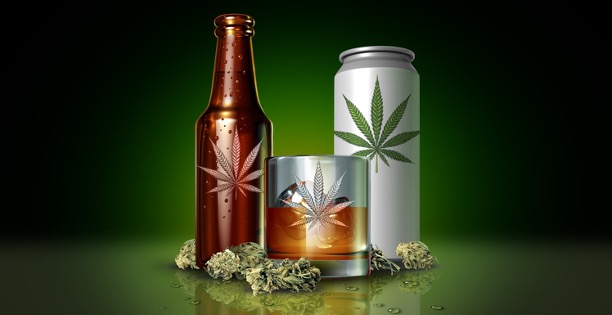For both traditional beverage manufacturers and cannabis brands just getting into drink formulation, there is one aspect of beverage formulation that too often goes unnoticed: its density or specific gravity (SpG).
If your brand is getting into cannabis drink production, you must understand how specific gravity drives uniformity of the emulsion, flavor, and sweetness within your recipe.
In this post, I will define specific gravity and outline what you need to know about its role in cannabis beverage formulation, including its effects on the quality, homogeneity, and stability of sweetened beverages.
What is specific gravity?
Specific gravity (SpG) or density in beverage formulation is used to quantify and monitor the concentration of dissolved ingredients, especially sugars, throughout the production processes.
It’s calculated by dividing the density of the ingredient in question (for example, a THC emulsion) by the density of the reference ingredient, which is typically water at a specific temperature. In every phase (water and oil phase), the SpG of your recipe needs to be taken into consideration. Like in a salad dressing, oil and water are not miscible, with the oil eventually floating on the water due to its lower SpG.
In brewing and winemaking, SpG is crucial because it is a measure of the alcohol content in the final product. In cannabis, while used differently, it’s just as important, since it affects the behavior of the emulsified cannabinoids and the uniformity and shelf stability of the beverage. Simply stated, if the SpGs are not balanced, the cannabinoids in the beverage will tend to separate and cream (float to the surface) over time..
Why specific gravity matters in cannabis beverages
Specific gravity can and does impact everything from your standard recipe to the final consumer experience. There is a reason why big beverage manufacturers pay close attention to this detail and why you should, too:
1. Standardize formulation from batch to batch
Matching SpG values ensures that every production run behaves the same in the tank, during production, on the shelf, and eventually when it finds its way into the hands of your customers. Without this control, one batch of seltzer may look fine while the next ends up with visible sedimentation.
2. Control mouthfeel and sweetness
Density directly impacts how flavorings and cannabinoids disperse. A 95-weight emulsion works in water-like seltzers, but in a more sugary base (like in sodas and juices) will tend to slowly separate, becoming unstable. Adjusting SgG to match each recipe is how big beverage formulators deliver consistent mouthfeel, sweetness, and flavor, whether they are producing canned alcoholic cocktails or a sparkling juice-flavored kombucha.
3. Comply with potential future nutrition labeling guidelines
I know; I know. Cannabis and hemp do not yet fall under the umbrella of FDA food labeling guidelines. But chances are that when they do shift to federal regulation, your label will come under this same mandate.
And U.S. nutrition labeling regulations require conversions between common household measures and equivalent metric quantities (milliliters). Specific gravity (density) is recognized as a factor for accurate conversion.
4. Guarantee safety and effects
Perhaps most importantly, SpG alignment ensures cannabinoids are evenly dispersed from the first sip to last. In a world where anyone can walk in off the street and purchase a cannabis beverage in a liquor store with no budtender to inform the cannabis newbie about the effects of your drink, it’s doubly important that your beverage does what it says on the label, just as a beer or canned cocktail would.
If a cannabinoid emulsion’s density doesn’t match the beverage, gravitational forces will eventually lead to creaming (cannabinoids rising) or sedimentation (cannabinoids sinking). This separation is not only unappealing, but it can also lead to unpredictable and uneven dosing. An unstable emulsion can leave one consumer underdosed and another overwhelmed. That’s bad for the consumer and for your brand trust.
Remember, your beverages will spend significant time, often 3 to 12 months, between manufacture, distribution, and on store shelves before being consumed. Stability and beverage uniformity must be maintained during that time. I see creating a–well-balanced beverage as an absolute requirement to satisfy both consumers and regulators.
Specific gravity: an emulsion for every formulation
Most cannabinoid emulsion manufacturers produce single-weight emulsions, typically with an SpG of 0.95. No matter what final product you have in mind, you’ll get an emulsion with this standardized SpG.
While this one-size-fits-all approach may seem highly versatile, it does not work in a world with an incredibly diverse range of products, ingredients, and varying Brix levels that drive sweetness. Degrees Brix (symbol °Bx) is a measure of the dissolved solids in a liquid, based on its specific gravity, and is commonly used to measure dissolved sugar content of a solution.
And as we also noted in the Comply with potential future nutrition labeling guidelines section, using a single SpG for all beverages regardless of your beverage’s density doesn’t follow food industry best practices. Using a single SpG for all your beverages is a lose-lose proposition for consumers and brands.
Keys to a stable cannabis drink formulation
To achieve long-lasting consistency and beverage uniformity (of particular importance, the uniformity of the active level), you have to pay attention to the specific gravity of the cannabinoid emulsion for every single beverage in your line. Many emulsions may look homogeneous at the time of bottling, but without proper SpG balancing, they can separate or stratify over shelf life.
The SpG of the emulsion that will work for a low-sugar seltzer will likely lead to separation and drink stability issues should you actually be making a sweeter, soda-style beverage.
And it’s not just sugar–you’ll also want to consider how the rest of the ingredients, from flavors to stabilizers, play into the final equation. My advice is to do the following:
- Validate formulations: Test across all SKUs, including every flavor variation within a specific product line. Since each ingredient in the recipe comes with unique characteristics and may interact with other ingredients in unpredictable ways, you’ll want to gather information across every single product in your lineup. Never assume that what is true for one product will be true for the next.
- Test, test, and test again: Don’t just perform stability testing during the initial pilot run. You must perform stability testing over the entire potential shelf life of the product, which may be upwards of a year. Emulsions in particular face constant stress from storage, transport, and gravity. These forces can quietly shift potency and uniformity, even if the product looks fine on the surface. That’s why stability testing over months and diverse conditions is essential to confirm cannabinoids stay evenly dispersed throughout the real-world full shelf life.
- Work with the right partner: If you’re not a food scientist, or cannabis expert, don’t worry; you don’t have to solve these SpG equations alone. The right cannabis emulsion partner will help you formulate and validate every SKU while taking specific gravity into consideration for each.
Conclusion
In this post, I defined specific gravity, explained why it matters for cannabis beverage formulation, and listed the dangers of formulating drinks–especially sugary drinks–without considering specific gravity.
With so many new cannabis beverages hitting shelves, the brands that stick around won’t just be the ones with cool marketing or even those tied to hot celebrities—they’ll be the ones people can count on. They’ll have the same flavor, same feeling, and the same effect every single time you crack open a can, from the first sip to the last.
The secret is to stop using the same emulsion for everything. Match your emulsion’s specific gravity to what you’re actually making, then back it up with solid testing. Do that, and you’ll build the kind of consistency that turns first-time buyers into repeat customers.





